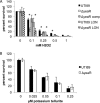Metabolic Requirements of Escherichia coli in Intracellular Bacterial Communities during Urinary Tract Infection Pathogenesis
- PMID: 27073089
- PMCID: PMC4959519
- DOI: 10.1128/mBio.00104-16
Metabolic Requirements of Escherichia coli in Intracellular Bacterial Communities during Urinary Tract Infection Pathogenesis
Abstract
Uropathogenic Escherichia coli (UPEC) is the primary etiological agent of over 85% of community-acquired urinary tract infections (UTIs). Mouse models of infection have shown that UPEC can invade bladder epithelial cells in a type 1 pilus-dependent mechanism, avoid a TLR4-mediated exocytic process, and escape into the host cell cytoplasm. The internalized UPEC can clonally replicate into biofilm-like intracellular bacterial communities (IBCs) of thousands of bacteria while avoiding many host clearance mechanisms. Importantly, IBCs have been documented in urine from women and children suffering acute UTI. To understand this protected bacterial niche, we elucidated the transcriptional profile of bacteria within IBCs using microarrays. We delineated the upregulation within the IBC of genes involved in iron acquisition, metabolism, and transport. Interestingly, lacZ was highly upregulated, suggesting that bacteria were sensing and/or utilizing a galactoside for metabolism in the IBC. A ΔlacZ strain displayed significantly smaller IBCs than the wild-type strain and was attenuated during competitive infection with a wild-type strain. Similarly, a galK mutant resulted in smaller IBCs and attenuated infection. Further, analysis of the highly upregulated gene yeaR revealed that this gene contributes to oxidative stress resistance and type 1 pilus production. These results suggest that bacteria within the IBC are under oxidative stress and, consistent with previous reports, utilize nonglucose carbon metabolites. Better understanding of the bacterial mechanisms used for IBC development and establishment of infection may give insights into development of novel anti-virulence strategies.
Importance: Urinary tract infections (UTIs) are one of the most common bacterial infections, impacting mostly women. Every year, millions of UTIs occur in the U.S. with most being caused by uropathogenic E. coli(UPEC). During a UTI, UPEC invade bladder cells and form an intracellular bacterial community (IBC) that allows for the bacteria to replicate protected from the host immune response. In this study, we investigated genes that are expressed by UPEC within the IBC and determined how they contribute to the formation of this specialized community. Our findings suggest that galactose is important for UPEC growth in the IBC. Additionally, we found that a gene involved in oxidative stress is also important in the regulation of a key factor needed for UPEC invasion of bladder cells. These results may open the door for the development of treatments to diminish UTI frequency and/or severity.
Copyright © 2016 Conover et al.
Figures








Similar articles
-
Adaptation of Arginine Synthesis among Uropathogenic Branches of the Escherichia coli Phylogeny Reveals Adjustment to the Urinary Tract Habitat.mBio. 2020 Sep 29;11(5):e02318-20. doi: 10.1128/mBio.02318-20. mBio. 2020. PMID: 32994329 Free PMC article.
-
Population dynamics and niche distribution of uropathogenic Escherichia coli during acute and chronic urinary tract infection.Infect Immun. 2011 Oct;79(10):4250-9. doi: 10.1128/IAI.05339-11. Epub 2011 Aug 1. Infect Immun. 2011. PMID: 21807904 Free PMC article.
-
The UbiI (VisC) Aerobic Ubiquinone Synthase Is Required for Expression of Type 1 Pili, Biofilm Formation, and Pathogenesis in Uropathogenic Escherichia coli.J Bacteriol. 2016 Sep 9;198(19):2662-72. doi: 10.1128/JB.00030-16. Print 2016 Oct 1. J Bacteriol. 2016. PMID: 27161114 Free PMC article.
-
Bacterial characteristics of importance for recurrent urinary tract infections caused by Escherichia coli.Dan Med Bull. 2011 Apr;58(4):B4187. Dan Med Bull. 2011. PMID: 21466767 Review.
-
Virulence factors of uropathogenic E. coli and their interaction with the host.Adv Microb Physiol. 2014;65:337-72. doi: 10.1016/bs.ampbs.2014.08.006. Epub 2014 Nov 4. Adv Microb Physiol. 2014. PMID: 25476769 Review.
Cited by
-
Reaching the End of the Line: Urinary Tract Infections.Microbiol Spectr. 2019 May;7(3):10.1128/microbiolspec.bai-0014-2019. doi: 10.1128/microbiolspec.BAI-0014-2019. Microbiol Spectr. 2019. PMID: 31172909 Free PMC article. Review.
-
The Nutrient and Energy Pathway Requirements for Surface Motility of Nonpathogenic and Uropathogenic Escherichia coli.J Bacteriol. 2021 Jun 1;203(11):e00467-20. doi: 10.1128/JB.00467-20. Epub 2021 Mar 29. J Bacteriol. 2021. PMID: 33782053 Free PMC article.
-
Urinary Tract Infection: Pathogenesis and Outlook.Trends Mol Med. 2016 Nov;22(11):946-957. doi: 10.1016/j.molmed.2016.09.003. Epub 2016 Sep 28. Trends Mol Med. 2016. PMID: 27692880 Free PMC article. Review.
-
What Flips the Switch? Signals and Stress Regulating Extraintestinal Pathogenic Escherichia coli Type 1 Fimbriae (Pili).Microorganisms. 2021 Dec 21;10(1):5. doi: 10.3390/microorganisms10010005. Microorganisms. 2021. PMID: 35056454 Free PMC article. Review.
-
Antibacterial activity of the novel peptide Pac-525 with the RGD motif against intracellular Escherichia coli.Sci Rep. 2025 Jun 6;15(1):19995. doi: 10.1038/s41598-025-04901-9. Sci Rep. 2025. PMID: 40481070 Free PMC article.
References
Publication types
MeSH terms
Substances
Grants and funding
LinkOut - more resources
Full Text Sources
Other Literature Sources
Medical
Miscellaneous
